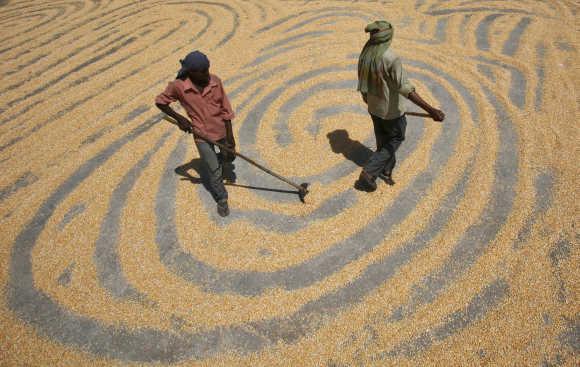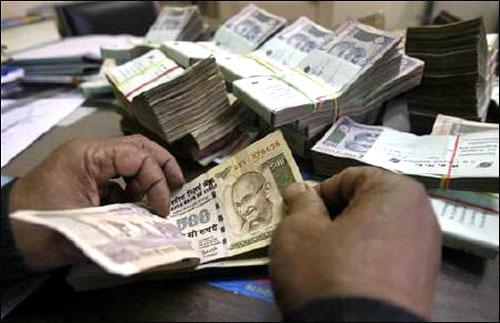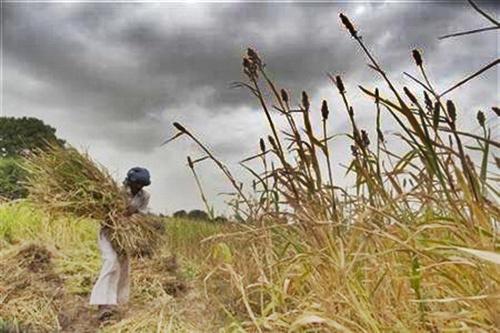
The Prime Minister's key economic advisor C Rangarajan on Friday lowered the growth forecast for the current fiscal to 5.3 per cent from 6.4 per cent projected earlier and listed out host of measures including further liberalisation of FDI norms to improve economic condition.
"Economy will grow at 5.3 per cent in 2013-14," Prime Minister's Economic Advisory Council (PMEAC) Chairman Rangarajan said while releasing the Economic Outlook for 2013-14.
The PMEAC had in April projected 6.4 per cent growth for Indian economy for current financial year. The GDP grew by 5 per cent in 2012-13.
RBI too had earlier lowered its growth projection for this fiscal to 5.5 per cent from 5.7 per cent.
In order to promote growth, Rangarajan suggested that the government should liberalise FDI investment norms, resolve tax concerns of the industry, fast track public sector investment and initiate measures to contain fiscal deficit.
...
Referring to the external sector, Rangarajan expressed hope that the Current Account Deficit (CAD) in 2013-14 will come down to $70 billion or 3.8 per cent of GDP, from $88.2 billion or 4.8 per cent a year ago.
As regards rupee, he hoped "at the current level (it) is well corrected. Stability is returning to the foreign exchange market. As capital flows return and as CAD begins to fall, this tendency will strengthen".
However, he added the current stance of monetary policy should continue until stability in rupee is achieved.
The rupee has lost over 20 per cent since April and had touched a life time low of 68.86 to a dollar on August 28. It is currently trading at 63.78 to a dollar.
Talking about government's resolve to bring down fiscal deficit to 4.8 per cent of GDP in 2013-14, Rangarajan said "containing (it) within the budgeted estimate could be a challenge".
...

The PMEAC expects the agriculture sector to grow by 4.8 per cent in the current fiscal up from 1.9 per cent, while the industrial growth has been pegged at 2.7 per cent as against 2.1 per cent in 2012-13.
The growth of services sector, however, is projected to decelerate to 6.6 per cent in current fiscal from 7.1 per cent a year ago.
Admitting that rupee depreciation will put some pressure on inflation, Rangarajan said "On balance, WPI inflation by end March 2014 will be around 5.5 per cent as against the average of 7.4% in 2012-13 and 5.7 per cent for March end 2013".
The wholesale and retail inflation widened in recent months primarily on account of higher weightage of food items in CPI.
The retail inflation in August stood at 9.52 per cent, while the WPI numbers in July was at 5.79 per cent.
Rangarajan said monetary policy had to tackle high inflation in last three years and it may switch to monetary easing with further moderation in inflation.
However, much of the monetary easing would depend on developments in the forex market, he said adding "controlling CAD remains the main concern at present".
...

The trade deficit, PMEAC said, would come down to around $185 billion in 2013-14, against an estimated $195.7 billion in 2012-13.
Between 2010-11 and 2012-13, the combined impact of higher net oil and net gold imports on the CAD was almost $57 billion or 3 per cent of GDP.
The CAD may go even below $70 billion in 2013-14 if the recent trends in exports and imports are maintained through the year, PMEAC said.
Net Capital flows are projected to fall to $61.4 billion in 2013-14 against an estimated $89.4 billion in 2012-13 putting pressure on the country's forex reserves.
"There may be a draw down of $9 billion from reserves against accretion of 3.2 billion in last fiscal," Rangarajan said. India's forex reserves stands at around $280 billion.
"For India, the short-term problem is of financing the large CAD, while the medium term issue is to compress CAD to a more sustainable level of around 2.5 per cent of GDP and ensure price stability," he said.
...
Rangarajan said containing fiscal deficit at budgeted level of 4.8 per cent of GDP would be a challenge in view of rising pressure on expenditure.
"Discretionary expenditure budgeted may need to be compressed, and subsidies restructured, in the remaining months of the financial year in a growth friendly manner to limit fiscal slippages," he said.
The fiscal deficit during the first four months of the current financial year has already reached 62.8 per cent of the budgetary provision for the full financial year.
"Some adjustment in domestic oil prices is inevitable to meet the fiscal deficit target," Rangarajan said.
Elaborating on the growth prospects, he said it would be higher in the current fiscal as against 5 per cent recorded in 2012-13. The GDP growth in April-June quarter fell to a four year low of 4.4 per cent.
...

Rangarajan hoped that the economy would perform better in the second half of 2013-14 as the impact of measures taken by the government over the last six months to promote growth would become visible.
In order to promote growth PMEAC has suggested a host of measures including easing FDI regulations, clarity on tax issues, focused attention on coal, power, road and railways, and construction of dedicated freight corridor.
Appreciating the Cabinet Committee on Investment (CCI) decision to fast track investment proposals, Rangarajan said it has cleared 209 projects worth Rs 3.84 lakh crore.
He also underlined the need for mid-course corrective steps to contain fiscal deficit, improvement in policy regime for sectors like sugar, urea, gas, roads and banking besides speedy approval of pending bills by Parliament.
Besides, Rangarajan also suggested long term measures to improve manufacturing capabilities, foreign investment, bond market, defence procurement, agriculture and energy sector.